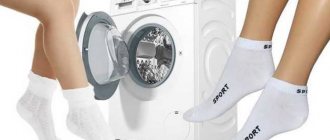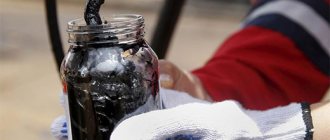1612.18
Author: Alla
No comments yet
Socks get dirty more than any other item and it takes a lot of effort to wash them. Sometimes you even have to download them for a long time.
Absolutely every housewife is familiar with the difficult task of washing socks. But how can this task be simplified? This is exactly what will be discussed in this article.
You can wash socks in several ways: by hand, in a washing machine, with pre-soaking or pre-washing.
Fresh dirt
How can you wash fresh dirt from white socks at home using available products? Use inexpensive recipes from the arsenal of experienced housewives.
- Laundry, alkaline soap . Lather your socks and leave them to soak for an hour. Then wash it.
- Lemon juice . Squeeze the juice from half a citrus. Add washing powder in a ratio of 2 parts juice + 1 part powder. Wet your socks, wring them out and rub them with this mixture. Leave for 2-3 hours.
- Lemon acid . You will need 5 liters of water at a temperature of 70-80℃. Add here 5-6 tablespoons of bleaching washing powder and 2 tablespoons of lemon juice. Soak your socks for a couple of hours. Wash and rinse by hand.
- Baking soda . Sprinkle soda thickly on wet socks after washing and rub gently with your hands so that the soda penetrates the fibers. Leave for an hour and rinse.
Here's how to clean white soles on any shoe made of any material. Read!
How to wash knitted, woolen and membrane items
Some types of fabric require a special approach. These include waterproof, wool and membrane.
How to wash children's clothes
Children's socks are made of knitwear, so they are washed by hand using baby or laundry soap, and also washed in a machine, choosing the “delicate” mode, since under normal conditions things can shrink.
Children's socks should not be washed with adult clothes.
How to wash something made from waterproof material
These socks can be washed by hand or in a washing machine; the water temperature should not exceed 40 degrees. Conventional products are not suitable for membrane fabric. Powders will clog pores, which can damage the item. The same effect can occur when washing with bleach and conditioners, and chlorine-containing products will lead to a loss of water-repellent properties of the product. In this regard, you should use special delicate products, as well as baby or laundry soap.
At the end of washing, the socks are turned inside out, wrung out, then turned inside out again and dried naturally. Waterproof items are not wrung out, so as not to damage the membrane responsible for the water-repellent effect.
An easy way to stretch socks after washing
Wool socks may shrink in size after washing in a washing machine, so the temperature should not exceed 30 degrees.
If they do shrink, you can stretch them in a simple way: wet the product and gently pull it with your hands in different directions. The socks will stretch a little. Another method will also help increase the size of a shrunken item.
You can stretch your socks with the inner tube of a volleyball: put it inside the sock and pump it up. It will take a few hours and the product will return to its size.
Now you know that washing socks has a lot of nuances. There are many ways to make this wardrobe item clean, some of them will definitely suit and come in handy for you. The most important rule is to wash your socks more often and they will not become so black with dirt that you have to throw them away.
Soaking socks before washing
Here's how to effectively wash white socks from dirt: choose a working solution and soak your socks in it for 1-2 hours. After soaking, the socks will wash much easier and cleaner.
Luckily, with white things there is room to turn around! There is no need to think whether the stain remover will bleach the fabric or not. These folk recipes have excellent reviews. If desired, after soaking the socks can be washed by hand rather than in a machine.
- Vinegar water : 0.5 liters of warm water + 1 tablespoon of table vinegar 9%.
- Boric acid : 1 tablespoon of acid per 1 liter of water.
- Lemon juice : juice of one citrus for 5 liters of water. Individual spots are treated with undiluted juice. The recipe is quite expensive. It is used for sports socks purchased for performances.
- Ammonia 10% : 2 teaspoons of ammonia per 1 liter of water.
- Baking soda : 4 tablespoons per 2 liters of water.
- Antipyatin soap . Legends tell about its capabilities. Antipyatin saves clothes from a variety of stains. Lather the socks, taking special care with the black soles. Leave for 2-3 hours. Wash by hand or machine.
- Homemade stain remover : will whiten socks that have turned gray from frequent washing. Prepare a solution: 5 liters of water, 1.5 tablespoons of turpentine and 1.5 tablespoons of washing powder (preferably oxygen). Stir well and soak the socks overnight or even for a day. Wash as usual. Please note: turpentine has a strong, unpleasant odor, so place the wash basin on the balcony.
Features of hand processing
Once the socks are sorted and free of dirt, you can start washing them.
Step-by-step instruction:
Pour water into a basin and dissolve the selected detergent in it.
In addition to classic washing, there are unusual methods for getting rid of dirt. A quick way is to put socks on your hands. Then they are soaped and intensively rubbed against each other.
Check out this unusual way to wash socks in the video:
Selecting a detergent
When choosing a detergent for washing socks, you need to start from the type of fabric from which they are sewn.
Synthetic and cotton products can be treated with soapy water and washing powder. Liquid formulations are used to care for delicate materials.
Water temperature
It is a misconception to wash socks in hot water. This is done only when additional disinfection of things is required. In other situations, it is enough to limit yourself to warm water.
Its optimal temperature is 40 degrees . It will not burn your hands and will not allow dirt to penetrate deeply into the fibers of the fabric.
Do you need a spin?
Socks can be wrung out after hand washing. This allows you to get rid of excess water and speed up the drying process.
However, there is an exception. It applies to wool products. Woolen socks are not wrung out, but placed on a rack immediately after washing .
They should dry naturally. If you squeeze them out, they will lose their shape and stretch out greatly.
After washing: what if THEY are still dirty?
How to wash white socks from black ingrained dirt that even washing in a washing machine did not remove? The last hope of the diligent Clean is bleaching in special solutions. You can, of course, use “Whiteness,” but it quickly destroys textile fibers and gives the fabric a yellowish tint.
Choose the appropriate recipe. Dip the socks completely into the liquid and straighten them with your hands. All bleaches contain caustic substances, first put on rubber gloves and keep children and pets away from the basin.
Bleaching agents for cotton
- Boric alcohol (or powdered acid). For 3 liters 2 tablespoons of acid. Soak the dirty sock for 2-5 hours. Boric acid easily removes black stains even on a trampled baby sock.
- Ammonia 10% . Recipe: 2 teaspoons of ammonia for 2 liters of water. Bleaching dirt for 2-3 hours.
- Table vinegar 9% . It will quickly return your socks to their snow-white color and get rid of unpleasant odors. Recipe: 1.5 liters of water, 200 ml of vinegar. Heat the water to 70-80℃ (this is the temperature of the water from which steam comes, or 5 minutes after boiling). Put your socks down. Leave it overnight. Wash with bleaching soap or powder. To make the fabric soft, rinse in water with 1-2 teaspoons of soda. Don't forget the gloves!
- Mustard powder . How to wash very dirty white socks? Take advantage of the whitening properties of hot mustard. Soap your socks with laundry soap and let them sit for 2-3 hours. Do the laundry. Heat the water to a temperature of 40℃ (your hand can tolerate it), add a few tablespoons of mustard (2 tablespoons per liter of water). Soak your socks for a couple of hours. After this you can machine wash it again. To avoid contaminating the drum, first rinse your socks to remove mustard powder.
- Hydrogen peroxide 3% + ammonia 10% . For 3 liters of hot water, add 3 tablespoons of peroxide and 1 tablespoon of ammonia. Dip the socks into the mixture, leave to soak for a day, after which all that remains is to wash. Be careful: ammonia is very caustic and causes burns to the respiratory tract, so do not snort the bottle. Peroxide also removes white laces.
Advice from "Chistyuli" . When preparing this article, I found advice online about soaking socks in a solution of potassium permanganate or boiling them. Since potassium permanganate gives things a brownish tint, I do not recommend using this recipe. As for boiling... I still remember my lost children's socks, which my mother, then not yet a very experienced housewife, boiled. The elastic bands stretched irrevocably and darkened.
Baking soda or soda ash gives amazing results
Bleaching agents for synthetics
Since pure cotton in socks is now as rare as snow in Africa, Cleaners have to think about how not to damage the delicate fiber, but at the same time wash effectively. Here's how to remove dirt from white socks made of synthetic fabrics: do not boil them, wring them out, or use products with chlorine.
Only such means are suitable.
It is allowed to use lemon juice and acid, laundry soap, hydrogen peroxide, and soda. All these recipes are above. Dishwashing gel also works well. Dilute the product with water and washing powder 1:1:1. Shake the mixture until foam appears. Rub the places that have to be washed off from dirt. After 2-3 hours, rub with your hands and wash in a machine.
Advice from "Chistyuli" . Socks made of synthetic fabrics quickly lose strength when washed in hot water (temperatures up to 70℃). Wash sports socks at 30-35℃. Never dry them on a radiator.
Wool bleaching
A sad story happened to my husband’s warmest down socks. I put one sock in the washing machine, not noticing that the second one was left in the laundry basket. Moreover, in a hurry, I set the wrong mode - I washed it at a temperature of 40℃, on the “synthetic” mode, with a spin speed of 400 rpm.
What cannot be washed in a washing machine?
On the tags of some things there is an icon - a schematic representation of a basin of water in which a hand is lowered. This is what makes us give up the washing machine. In most cases, manufacturers play it safe so that they are not held liable in the event of a defect after machine washing. But sometimes a washing machine can really damage the product. Also, you should not put things with certain types of dirt into the machine.
What can't be machine washed?
- Items contaminated with oil products - gasoline, machine oil, kerosene. If they get on the rubber parts of the machine, they can corrode them. When contamination is extensive, flammable vapors can cause an explosion.
- Clothes made of leather and faux leather. The product will lose its shape and color.
- Delicate lace items (unless a delicate wash cycle is provided). Under normal conditions, the lace may tear.
- Products with a rigid shape - suits, coats, hats. But washing in a basin is also not recommended for them. Better take them to the dry cleaner.
Unlike machine washing, you can wash everything by hand. Well, or almost everything - with the exception of things that require chemical treatment.
Table. How to determine the material of socks
| Cotton, linen |
|
| Wool |
|
| Synthetics |
|
| Polyester |
|
When should you boil?
White items are boiled with the addition of detergent when they have stubborn stains or have turned yellow. Colored and black socks are boiled to disinfect them. This procedure is also carried out to remove persistent sweat odor.
Algorithm of actions:
During boiling, the products will float, so they need to be heated from time to time.
Ready-made stain removers
The stain remover is added to the washing machine or the product is soaked in it for an hour, preparing the solution according to the instructions.
- Domestos (Domestos) . Not exactly a target product, so I’ll immediately give you the recipe for the solution. Dilute the product with warm water 1:1. Soak the socks for 5 minutes and wash. Domestos contains chlorine and can leave white stains on colored clothes.
- Aquarius (Aquarius) . Italian oxygen stain remover. Confidently and effectively removes stains from white or colored items. Not suitable for wool, silk, delicate fabrics.
- Vanish Oxi Action (Vanish) . Removes fresh stains and disinfects clothes. Add to the powder when washing in a basin or machine, as well as when soaking things. Doesn't remove old stains well, but is very effective at removing fresh dirt.
- "Bos" . Oxygen bleach, in the product line for white and colored laundry. Gently removes stains during soaking and during the main wash. Disinfects textiles. A good budget product.
- "Myth" . Washing powder for white and colored clothes. Acts as a washing powder activator and as a stain remover. Removes dirt quite well. Easily rinsed out of fibers.
- "Sarma" . Bleach works even in cool water and is used for both hand and machine washing. Safe for all types of fabrics.
- Dosia (Dosya) . Effective at temperatures 30-60℃. It also easily removes stubborn stains.
- "Eared Nanny" . The product contains only non-aggressive components, so the product is suitable for any fabric. Effective against stains and stubborn odors.
- Ase (Ace) . Also suitable for hand and machine wash. It not only whitens stains, but also refreshes the entire item. Removes gray plaque that has appeared over time.
- Synergetic (Synergetic) . Suitable for wool, silk or cotton. Removes dirt stains and traces of faded paint. A line of safe, environmentally friendly products.
Top products that experts like
First of all, pay attention not only to the effectiveness of the powder, but also to safety. Below are drugs that fully meet these criteria:
- Persil machine Frosty freshness. It contains liquid encapsulated stain remover. It copes with even the most stubborn stains and returns the laundry to its original color. Can be used for both dark and white products from any type of textile. One of the advantages is the complete absence of harmful phosphates. As for the minuses, the amount of non-anionic and anionic surfactants is slightly exceeded. Among other things, the smell of fragrances remains on the linen and is not washed out of the fibers.
- Spark Drum Laundry Detergent. Its detergent base includes zeolite and several types of surfactants. In addition, here you can find soda, sea salt and enzymes (natural proteins), supplemented with extracts from natural lemon, pine needles and green tea. Spark Drum Laundry Detergent is quite economical because it is a concentrate (requires dilution before use) and does not lose its declared properties even in very cold water.
- Frosh Color aloe vera. Perhaps this is the best powder in terms of price and quality. The product contains aloe extract, which helps soften linen. In addition, it helps to neutralize possible allergies to components of chemical origin. Another advantage of Frosh Color aloe vera is that it is completely free of optical brighteners, bleach, silicates and phosphates. Also, after rinsing you will not notice any odor.
Which drugs to choose?
If clothes are dyed white during washing, you can remove unnecessary stains on the fabric with a regular solvent.
When purchasing, make sure that the packaging is marked White
You can also use active oxygen bleach. “Whiteness” is more budget-friendly. It should be remembered that with constant use it can seriously damage things.
For colored matter that has become pale over time, there are other means. All of them are marked Color. These Korean-made stain removers are considered one of the most effective. These are Oxi Clean and Paracle.
When using any shade restorers, remember that it is necessary to restore the color using protective equipment (gauze bandage and rubber gloves).
This is due to the fact that such drugs are capable of releasing toxic fumes that can enter the respiratory tract and mucous membranes (for example, the German Doctor Bekman). Therefore, use such bottles wisely and strictly follow the instructions.
How to get rid of black soles
The soles of socks get dirty faster and more heavily, and white textiles seem to attract dust and dirt. Here's how to remove white socks from black soles with minimal effort.
- Remove any stuck debris from the surface of your socks: threads, hair, etc. When washed in hot water, colored threads may fade and leave noticeable marks on the socks.
- Properly soap your soles with laundry soap. After this, it will be much easier to wash off the dirt.
- Now soak the socks in a solution of boric acid (1 teaspoon of the substance per 1 liter of water). Leave for 2-3 hours. Rinse and wash thoroughly to remove any remaining boric acid.
- Or instead of boric acid, use hydrogen peroxide 3%. The recipe is the same.
Advice from "Chistyuli" . For socks whose soles have turned black, wash them thickly with any soap and put them in the washing machine. I use this method all the time, and on socks of any color. The recipe is very effective!
Article information
This article was produced by our experienced team of editors and researchers, who reviewed it for accuracy and comprehensiveness.
Category: Housekeeping tips
In other languages:
English: Wash Clothes by Hand, Français: laver des vêtements à la main, Italiano: Fare il Bucato a Mano, Español: lavar la ropa a mano, Português: Lavar Roupas à Mão, Nederlands: Kleding met de hand wassen, 中文: 用手洗衣服, Čeština: Jak prát v ruce, Bahasa Indonesia: Mencuci Pakaian Menggunakan Tangan, العربية: غسل الملابس باليد, ไทย: ซัก Name: Deutsch: Kleidung von Hand waschen, Name: Name: Name:服を手洗いする, 한국어: 손 빨래하는 방법, Tiếng Việt: Giặt quần áo bằng tay
This page has been viewed 149,750 times.
Was this article helpful?
Not really
Tips from the forums
For light-colored socks, the sole wears out first.
Many Cleanies generously share their experience on how to wash dirt off white socks. Here are some simple recipes. They are all workers.
- Soap (laundry soap, Ushastiy Nyan, Duru, Sarma) + Udalix stain remover. Lather your soles thoroughly and leave for 2-3 hours. Then soak overnight with Udalix powder. Wash by hand or machine.
- "Domestos" . Soak your socks in water with Domestos added. Wash it in an hour.
- Baking soda + washing powder . Add ingredients to water and stir. Soak your socks overnight.
- Gel SA8 . Add the gel directly to the machine, strengthening the washing powder. If necessary, you can strengthen the gel with Vanish stain remover.
- Dishwasher tablets . Place one tablet in a basin, add 5 liters of water. Stir until the tablet dissolves. Soak your socks for several hours. Spin it in the washing machine.
- Ammonia 10% . Add 2-3 teaspoons of ammonia to the same bowl of water. Get your socks wet.
Preparation for the process
Before you start washing your socks, you should prepare them:
To improve the quality of subsequent washing, it is recommended to pre-soak light-colored socks.
For this, both regular washing powders for white laundry and solutions from improvised products are suitable:
The basin is half filled with warm water (no more than 30 °C) and the selected product is mixed into it . Then the laundry is immersed there and left for at least 3 hours (if it is very dirty, it can be longer). After this, you can start washing.
To correctly determine the method of washing socks, do not throw away the tags from new pairs. They usually contain important information about the product and care instructions from the manufacturer.
How to dry socks quickly
Sometimes you need to dry your socks at home quickly. I usually do this if the house is cool and my socks need to be dry in the morning. For example, you often forget that today the child put on his last clean pair of socks, and in the morning he needs a clean pair.
- Wrap your socks in a towel and twist them out. Hang in a draft to dry.
- Gently dry your socks with an iron. Set the mode to minimum and do not keep it in one place for a long time, so as not to “fry” your socks.
- Open each sock and hang them so that a stream of air blows right through the fabric. Dry with a hairdryer.
I spotted an interesting method in the village. To dry thick woolen socks overnight, they are stuffed with straw and placed over the stove. In the morning, put on clean, warm woolen socks.
How to wash children's white socks: recommendations, approved products
White socks look especially touching on children, but a child is able to bring them to a state that adults have never dreamed of.
Any method is suitable for washing and whitening children's socks, but you need to remember that children's skin is extremely sensitive and delicate. So all children's clothes need to be rinsed thoroughly and repeatedly. Even lemon juice can cause irritation if your child is allergic to citrus fruits.
If you take proper care of your white socks, they will retain their attractive and fresh appearance for a long time. However, no matter how much you take care of them, someday you will need new ones.
So…
Relax while washing and achieve excellent results?
With “Clean” it’s not difficult! How to wash white socks from dirt at home? Choose a recipe that suits your fabric. Choose a homemade or ready-made stain remover. If necessary, soak your socks. Keep them in the solution for the required time. Rinse and evaluate the result. Repeat the procedure if necessary. Good luck!
Share useful information with your friends:
Nuances for products of different colors
On white socks, dirt is more noticeable than on dark ones. Therefore, you have to wash them after every wear. To prevent the products from turning yellow, you can use bleaches.
Colored and black socks tend to release coloring pigment. Therefore, it is recommended to wash them at a temperature of no more than 35-40 degrees.
Do not use products containing chlorine or other bleaching ingredients to soak colored items. They are boiled only when necessary, for example, for the purpose of disinfection.
If there is a stain that is difficult to remove on colored items, you can get rid of it using ammonia and glycerin . The product is mixed in a 1:2 ratio and applied pointwise to the contaminated area with a cotton pad. When the stain is removed, the pair is washed as usual.
Black, colored and white socks are always soaked and washed separately.











